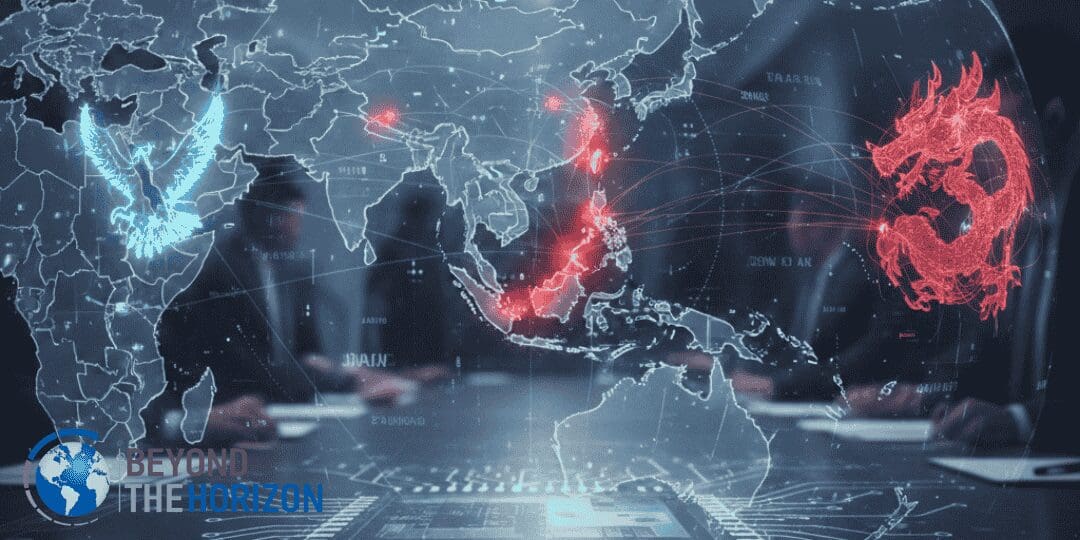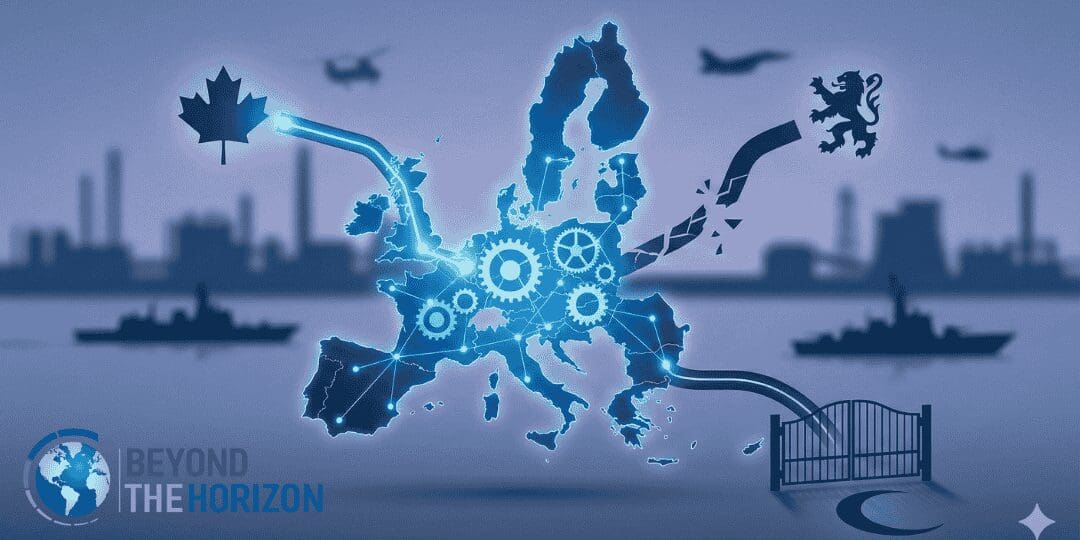Key Takeaways
- AUKUS is evolving beyond its original three members. What began as a narrow U.S.–UK–Australia submarine pact is now functioning as the nucleus of a wider, networked alliance framework oriented around undersea deterrence and advanced military technology.
- South Korea has crossed a historic threshold. Washington’s unprecedented decision to share nuclear-propulsion technology with Seoul – combined with South Korea’s decision to build SSNs in a U.S. shipyard it owns – represents a major break with past U.S. restrictions and effectively creates an “AUKUS Plus” dynamic.
- Japan is edging toward the framework – but cautiously. Tokyo is currently positioning itself through AUKUS Pillar II advanced technology cooperation rather than pursuing nuclear propulsion, reflecting both political constraints and strategic hedging.
- A genuine “networked deterrence coalition” is forming. Shared submarine production, distributed technology development, and industrial burden-sharing are replacing siloed bilateral arrangements, reshaping Indo-Pacific power balances.
- But the cost is escalation risk. Expanding nuclear-propulsion access weakens traditional non-proliferation norms and invites backlash. China and North Korea are already exploiting these moves to justify further military expansion.
- The undersea domain is becoming the new arms-race frontier. More nuclear-powered platforms operating in contested waters mean higher risk of miscalculation, greater operational opacity, and intensified great-power naval rivalry.
- The next decade will be decisive. If Seoul and Tokyo deepen their integration, AUKUS becomes a hub-and-spoke alliance for advanced military technology. If they hesitate, the region may fragment into parallel deterrence strategies. Either way, the strategic ballast of the Indo-Pacific is shifting underwater.
Introduction
The Indo-Pacific security architecture is undergoing a subtle but significant transformation. At its core lies the AUKUS agreement, a trilateral pact launched in 2021 by Australia, the United Kingdom, and the United States to help Australia acquire nuclear-powered submarines and collaborate on advanced defense technologies. Now, Japan and South Korea appear to be moving toward alignment with AUKUS-style capabilities, particularly in undersea deterrence. This evolution signals a shift from traditional bilateral alliances toward a broader networked framework – one centered on nuclear propulsion, cutting-edge shipbuilding, and integrated maritime power – that could redefine power balances in East Asia. In effect, what began as a three-nation submarine pact may be re-wiring the undersea future of the Indo-Pacific, with nuclear submarines as just the visible tip of a deeper strategic shift.
South Korea’s Entry Path into the Nuclear-Sub Club
South Korea has rapidly emerged as a key candidate to join the exclusive “nuclear sub club” alongside AUKUS members. In late 2025, a major hurdle was cleared when the United States – in an unprecedented policy reversal – agreed to share nuclear-propulsion technology with Seoul, effectively giving South Korea the green light to build its own nuclear-powered attack submarines (SSNs). U.S. President Donald Trump announced in October 2025 that he “gave [South Korea] approval to build a Nuclear Powered Submarine”, noting that South Korea’s current diesel-electric boats are “old fashioned, and far less nimble”. This decision was a watershed moment: until now, the U.S. had shared sensitive naval reactor know-how only with Britain (in the 1950s) and more recently with Australia under AUKUS. By effectively extending this privilege to South Korea, Washington overturned the prior stance that AUKUS was a “one-off” exception and opened the door for a broader alliance approach to undersea capabilities.
The U.S. consent for South Korea’s SSN program is tied to a unique industrial arrangement. The plan envisions South Korea building its nuclear-propelled submarines in the United States – specifically at the Philadelphia Naval Shipyard, which was acquired and modernized by South Korea’s Hanwha Group in 2024. Trump’s announcement explicitly highlighted that “South Korea will be building its Nuclear Powered Submarine in the Philadelphia Shipyards… U.S. shipbuilding will soon be making a BIG COMEBACK.” This reflects a broader “Philly Doctrine” blending alliance strategy with industrial policy: in exchange for access to nuclear sub technology, Seoul is investing heavily in U.S. industry, aligning with Trump’s Make American Shipbuilding Great Again (MASGA) initiative. Indeed, South Korea pledged a massive $150 billion in shipbuilding investments as part of a wider $350 billion U.S. investment package – a deal aimed at lowering U.S. trade tariffs on Korea while boosting American infrastructure. For Washington, this transactional approach ensures that allied cooperation on SSNs also serves U.S. domestic ends, revitalizing a strained shipbuilding base with foreign capital and expertise.
From Seoul’s perspective, acquiring nuclear-powered subs offers clear strategic and operational benefits. An SSN capability would provide South Korea with vastly improved submarine endurance, speed, and power projection far beyond the Korean Peninsula – a “credible deterrent” that can patrol for extended periods and even operate in the broader Indo-Pacific theater. South Korea faces an increasingly complex security environment: China and Russia both deploy nuclear-powered submarines in regional waters, and North Korea is reportedly developing its own nuclear-propelled, possibly nuclear-armed, submarine with foreign technical help. Directly confronting three nuclear-armed neighbors, Seoul sees nuclear subs as vital to restore a balance of deterrence. Extended patrol SSNs would improve Seoul’s maritime domain awareness and allow it to help track Chinese or North Korean subs, thereby “reducing the burden on U.S. forces” in regional waters. In essence, South Korea’s entry into the nuclear-sub arena enhances its maritime autonomy and alliance value: Seoul will be contributing advanced undersea capabilities to the U.S.-led network, rather than relying solely on American extended deterrence.
Strategically, some analysts see South Korea’s SSN project evolving into an “AUKUS Plus” model of cooperation. In this vision, South Korea would not merely obtain submarines but also become integrated into the broader AUKUS framework as a fourth partner, contributing its significant industrial capacity and hard-won shipbuilding expertise to the alliance. South Korea’s shipbuilders – like Hanwha Ocean, HD Hyundai, and Samsung Heavy Industries – are among the world’s most advanced, and they already manufacture sophisticated conventional submarines for domestic use and export. By leveraging Korean industry, an AUKUS-Plus approach could distribute submarine production more efficiently across allies and help overcome bottlenecks in U.S. and UK shipyards. In fact, Seoul’s participation could rapidly boost output: analysts note South Korea might field nuclear subs years before Australia, given its head start in shipbuilding and simpler decision-making process. If realized, such co-production would deepen interoperability with the U.S. (and Australia) and firmly anchor South Korea in a networked undersea deterrence coalition rather than a standalone bilateral arrangement.
Japan’s Strategic Dilemma and Possible Alignment
For Japan, the prospect of joining or aligning with an AUKUS-style undersea framework presents both opportunities and dilemmas. Japan is one of America’s closest allies and possesses a highly advanced military-tech base, yet it remains officially under its post-WWII non-nuclear principles and has thus far operated only conventionally powered submarines. The rapid submarine developments by its neighbors – including China’s expanding fleet of nuclear subs and now South Korea’s SSN plans – are quietly raising the pressure on Tokyo’s strategic calculus.
In the near term, Tokyo appears more inclined to cooperate under AUKUS “Pillar II” rather than pursue its own nuclear subs. Pillar II of AUKUS focuses on joint work in cutting-edge domains like AI, cyber warfare, underwater drones, quantum computing, and hypersonics – areas where Japan’s sophisticated tech industry and research community would be natural partners. Indeed, the AUKUS nations have explicitly expressed interest in partnering with Japan on advanced capabilities. U.S., UK, and Australian officials noted in 2024 that incorporating other partners into Pillar II was “always part of the plan,” and they specifically highlighted Japan’s value given its technological prowess and close ties to all three AUKUS members. In July 2025, Japan took a concrete step by participating in an AUKUS Pillar II exercise (Maritime “Big Play” drills during Talisman Sabre 2025), where AUKUS partners and Japan jointly tested autonomous underwater vehicles and advanced undersea communications. A joint Australia–Japan 2+2 statement welcomed this inaugural cooperation and vowed to explore “further opportunities for cooperation between AUKUS partners and Japan on advanced capability projects under Pillar II.” This indicates that Japan is edging closer to AUKUS’s orbit, at least in terms of technology sharing and interoperability, even if it has not (yet) signed on to the submarine pact itself.
The strategic logic for deeper Japanese alignment with an AUKUS-style framework is compelling. First, Japan aims to remain highly relevant in U.S.-led alliance architecture as the regional environment grows more perilous. If AUKUS evolves into a broader Indo-Pacific defense network, Tokyo would not want to be left on the sidelines. By plugging into Pillar II projects (and potentially any future “AUKUS-Plus” arrangements), Japan ensures it has a seat at the table of cutting-edge defense innovation, alongside fellow maritime democracies. Second, maritime deterrence credibility is at stake. The Japan Maritime Self-Defense Force (JMSDF) operates a capable diesel-electric submarine fleet, but these boats lack the endurance and global reach of nuclear-powered ones. As China’s navy surges in both quality and quantity, and if South Korea in the 2030s fields SSNs, Japan may worry that solely conventional submarines could diminish its deterrent edge. Third, there are industrial benefits. Japan recently began loosening its self-imposed restrictions on defense exports and cooperation. Its world-class shipbuilders and electronics firms (Mitsubishi Heavy Industries, Kawasaki, Toshiba, etc.) could gain access to new projects and markets by collaborating with AUKUS partners. For instance, Australia in 2025 selected Mitsubishi to build 11 advanced frigates, underscoring the growing defense-industrial synergy between Japan and AUKUS members. A similar synergy could extend to submarine-related technologies – whether air-independent propulsion, battery systems for submersibles, or AI-driven targeting – where Japanese innovation would be highly valued.
Yet Japan must balance these opportunities with domestic and regional sensitivities. The country’s war-renouncing constitution (Article 9) and long-standing public aversion to nuclear technology for military use impose political constraints. While operating a nuclear-powered submarine is not the same as deploying nuclear weapons, any move by Tokyo in that direction would spark intense debate at home. There is a “perception gap” in Tokyo, as noted by experts, where AUKUS is sometimes seen as a closed Anglosphere club – and Japanese leaders have not built a domestic consensus on how or if to engage with it. So far, the official line is cautious: Japan is exploring possibilities for cooperation but avoids framing it as “joining AUKUS” outright.
Conclusion
The potential entry of Japan and South Korea into an AUKUS-style nuclear-submarine framework marks a historic turning point for Indo-Pacific alliances. What began in 2021 as a narrow trilateral pact to equip Australia with nuclear-powered submarines is gradually evolving into a broader alliance network centered on undersea deterrence and high-tech defense cooperation. For Seoul and Tokyo, aligning with this framework offers clear benefits: enhanced deterrent capabilities, greater strategic autonomy, and deeper integration into U.S.-led security architectures. South Korea’s case shows how an ally can leverage industrial strength to gain cutting-edge military tech, thereby bolstering its own defense while also contributing to alliance objectives. Japan, by engaging in AUKUS Pillar II, stands to access and influence the development of critical technologies, ensuring it stays at the forefront of regional security initiatives. For Washington and its AUKUS partners, expanding the circle brings much-needed industrial relief and burden-sharing – easing pressure on U.S./UK shipyards and injecting fresh resources and innovation into joint projects. In essence, a “networked deterrence coalition” is emerging, one that pools the technology, industrial bases, and naval assets of multiple allied nations to maintain an edge over rival powers.
However, this evolution also comes with weighty strategic trade-offs. It stretches the traditional limits of non-proliferation policy, creating new challenges for safeguarding nuclear technology and avoiding an erosion of global norms. Regionally, it risks intensifying the very competition it seeks to counter: China and North Korea are already seizing on these developments to justify their own military expansions, warning of countermeasures and painting the allies as aggressors. The undersea domain – long a shadowy arena of great power contest – could become even more contested and congested as more countries deploy stealthy platforms. Managing this “arms race under the waves” will require careful diplomacy, transparency measures, and alliance coordination to prevent incidents and miscalculations.
In sum, Japan and South Korea’s steps toward an AUKUS-style framework underscore that the Indo-Pacific’s security order is being fundamentally reshaped. AUKUS is no longer just an Anglosphere submarine deal; it is the nucleus of a growing security ecosystem aimed at sustaining a favorable balance of power. The coming decade will reveal whether this experiment yields a more secure region through collective strength, or whether it sparks new instabilities that allies must work hard to contain. The only certainty is that the strategic stakes are deep beneath the ocean’s surface – and the submarine hulls appearing on allied drawing boards are only the first glimpse of the far-reaching changes underway.





